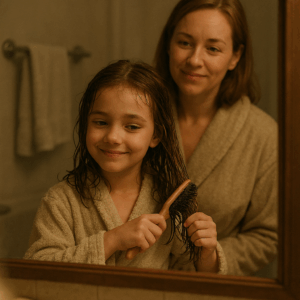On this page
Children who have difficulties coordinating their movements, may find washing their hair difficult. This is due to the task requiring good balance, coordination of the hands, and knowing where their body is in space.
Tips to help your child wash their hair independently
- Ensure the bath/shower area has everything the child needs before starting to wash their hair.
- Encourage your child to start the activity themselves, then help them finish as necessary
- To allow your child to see where to place their hands when washing their hair, place a mirror in the bathroom at head height
- If your child finds using a shampoo bottle difficult, try use a soap dispenser instead as a pump action can be easier for them to control
- If your shower has a hose, encourage your child to use this to help wash the shampoo off.
- Look for goggles or a special hat if your child is worried about soap getting in their eyes when washing their hair
- For children who have difficulties maintaining balance, ask them to sit in the bath or sit on a shower chair when washing their hair.
- Put a different colour sticker or on the shampoo and conditioner bottles, to help your child know which is which.
- Allow your child to build up independence at each step of washing their hair, then move onto the next until they can complete the activity themselves.
- Establish a routine so they are aware of when they are going to be washing their hair, or you will be washing their hair.
- Keep visual and audio stimuli minimal to allow for a calming environment for your child.
- Stay calm and reassure your child as necessary
- Check the correct amount of shampoo is being used
- Check they are washing the lower part of the scalp.
Tips for hair washing when a child is sensitive to touch
- Keep your child’s hair shorter to make washing their hair quicker and easier for them.
- Try unscented shampoo.
- Prepare and explain to your child what you are about to do when washing their hair so they know and understand what is happening.
- Ask your child to hold a flannel when washing their hair if they are scared of water or shampoo touching their eyes.
- If your child does not like water in their ears, try ear plugs.
- Ask your child why they do not like their hair being washed, so you can understand their reasoning and adapt the activity as needed so the activity is less distressing for them.
- To help spread shampoo in their hair, try a hair washing brush.
Tips to help a child independently brush their hair

- Use a thick handled brush so it is easier for your child to grasp it.
- Use a long handled brush if your child is having difficulty reaching the back of their head
- Use detangling spray before brushing their hair, to make the hair easier to brush
- Allow your child to use role play to practice the hair brushing action, such as using dolls
- Allow time for your child to be able to brush their hair, as the activity may take longer when they are learning to do this
- Braid or tie up your child’s hair to reduce the amount of knots, making it easier for them to brush their hair
- Encourage your child to try brush their hair by themselves, and ask you for help as they need to. They may not be able to brush all of their hair independently when they are learning.
Tips for helping a child who finds hair brushing stressful
- Maintain a relaxed and calm atmosphere when your child is brushing their hair
- Warm water can help create a calming effect
- If you are brushing your child’s hair, give them toys to distract them to make the activity less stressful for them
- Use detangling spray or wet the hair to help the brush through more easily
- Let your child do the activity, so they can apply the pressure and pace that they feel they can tolerate.